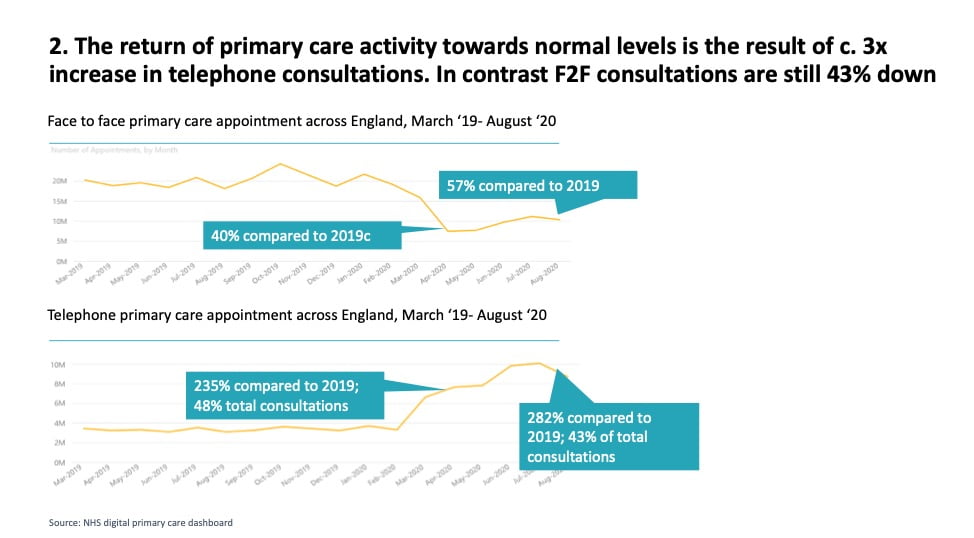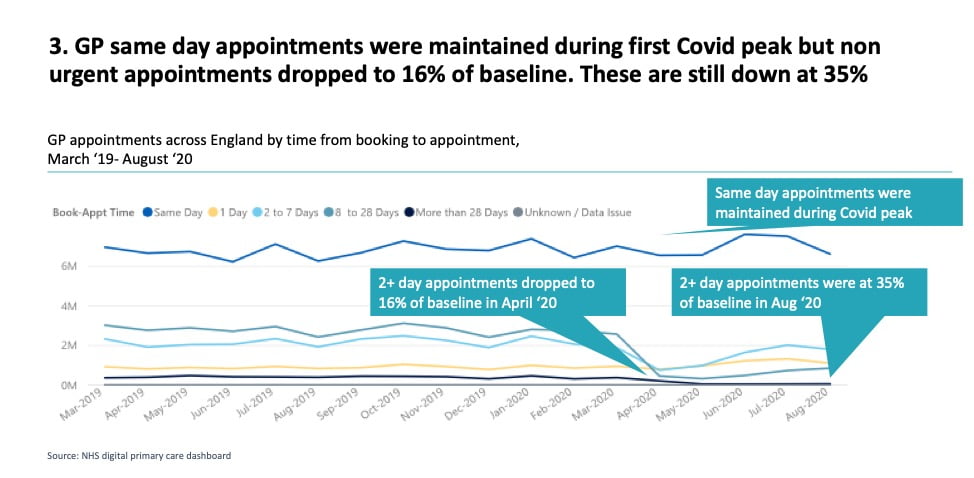The fantastic NHS Digital primary care dashboard provides some interesting findings:
- Total primary care activity across all channels has returned from 67% at the peak of Covid to 88% in August ‘20
- The return of primary care activity towards normal levels is the result of an almost tripling of telephone consultations compared to same month in 2019. In contrast face to face consultations are still 43% down
- GP same day appointments were maintained during first Covid peak but non urgent appointments (2+ day appointments) dropped to 16% of baseline. These are still down at 35%
- In contrast other practice staff non urgent appointments whilst dropping to 30% during Covid have now returned to 71% of baseline
- We reflect that we would expect total primary care activity to be at greater than 100% of baseline if suppressed demand and new Covid related demand is to be met. This suggests an element of unmet demand
- We also hypotheseise that the drop in non urgent GP primary care apppointments may indicate a potential drop in GP led proactive chronic disease management activity
- Urgent work is needed to further explore this
Analysis

- Total primary care activity is still below baseline, whilst we would expect that demand will be greater than 100% of baseline due to suppressed demand and Covid related new demand (including mental health consequences of social isolation)

- Telephone consultations have almost tripled compared to last year. In August they accounted for 43% of total consultations
- In contrast, face to face consultations are only at 57% of baseline
- Of note video and online consultations still only account for 0.4% of total consultations


- GP activity for urgent appointments (Same and 1 day appointments) was maintained during Covid first peak and has continued at same level as last year. However non urgent appointments (2+ day) dropped to 16% of baseline and this still hasn’t returned to baseline
- In contrast whilst non urgent appointments provided by other practice staff (including practice nurses and primary care pharmacists) also fell to 30% of baseline during Covid it has returned to 70% of baseline activity
Discussion
Whilst total primary care activity has significantly increased since the Covid first peak, it is still below baseline. We would anticipate that demand would be above 100% of baseline due to suppressed demand and Covid related new demand (including mental health consequences of social isolation). This suggests that there is significant unmet demand. This is likely to be caused by a combination of:
- Patients still not presenting to primary care
- Ongoing primary care capacity limitations caused by Covid infection control guidelines and quarantine
Mangement of long term conditions appears to be a particular concern. The return of other practice staff non urgent appointments towards baseline will mean that immunisations, screening and medication reviews are being caught up on. However, in contrast there is an ongoing low level of 2+ day (non urgent) GP appointments. We speculate that this is caused by a combination of:
- Some urgent appointments being used to carry out routine care (because of a drop in acute demand)
- An ongoing lack of capacity for face to face apppointments (which these are more likely to be)
- A focus of available GP capacity on same and 1 day predominantly telephone appointments to the detriment of organising proactive long term management appointments
- An ongoing choice by patients to stay away from primary care except for urgent issues. This is likely to be compounded by patients with multiple long term conditions choosing to continue shielding
This is concerning because it will have an impact on long term condition management and likely on outcomes. This is particularly so because there has not been the opportunity to catch up on the previously suppressed activity from the first Covid peak.
It is really welcome to see this data in the public domain. We recommend that:
- Further work is needed to understand the split of primary care activity across urgent and non urgent care and to understand if there is indeed a gap in long term condition management
- Primary care will need to explore how the balance is re-struck between provision of urgent on the day care and proactive management of long term conditions. This will include exploring the right split between face to face and virtual consultations



